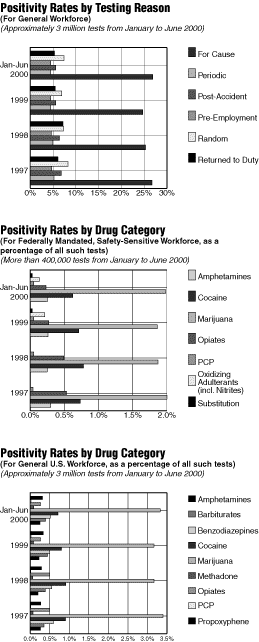Workers attempt to scam drug tests less often
Cheating on workplace drug tests by using chemical additives called masking agents or oxidizing adulterants declined sharply during the first half of 2000 compared to 1999, according to the semiannual Drug Testing Index recently released by a drug-testing company, Quest Diagnostics of San Diego. (See sample graphs.)
|
|
|
Source: Quest Diagnostics, San Diego. Web site: www.questdiagnostics.com. |
The Drug Testing Index summarizes the results of workplace drug tests performed between January and June 2000 by Quest Diagnostics.
The Drug Testing Index looks at positivity rates among three major testing populations:
• federally mandated, safety-sensitive workers;
• the general work force;
• the combined U.S. work force.
The proportion of individuals who used masking agents to thwart the drug testing process declined by 48% during the first half of 2000 compared to the prior year period, according to the Drug Testing Index. Quest Diagnostics is the nation’s leading provider of diagnostic testing, information and services with annualized revenues of more than $3 billion.
Masking agents are chemicals that are added to drug testing specimens in an attempt to defeat the process of detecting drug use.
These agents include oxidizing adulterants, which include nitrites, as well as bleach and pyridinium chlorochromate. Quest Diagnostics initiated adulterant testing in April 1998 as a complement to workplace drug testing, and expanded its adulterant testing to include additional oxidizing adulterants as well as "substituted" specimens in early 1999.
During the first half of 2000, 0.12% of the individuals evaluated tested positive for the presence of oxidizing adulterants, compared to 0.23% in 1999. In addition, 0.03% of the total specimens were identified as having been "substituted" for valid test specimens, compared to 0.04% in 1999.
Test results are reported as "substituted" when samples do not contain certain chemical components characteristic of normal human urine, says R.H. Barry Sample, PhD, director of science and technology for Quest Diagnostics’ Corporate Health and Wellness division.
More surveillance = less cheating
"The significant decline in the incidence of cheating on drug tests appears to be closely linked to the heightened surveillance by our clients using specimen validity testing to detect tampering," Sample says. "As more and more employers have begun to test for the presence of adulterants and substituted specimens, cheaters no longer can rely on techniques they may have successfully used in the past."
Overall, workplace drug use, as measured by the rate of positive samples among all samples, remained unchanged from 1999 at 4.7% of the approximately 3 million workplace drug tests performed during the period.
Rates of use for several drugs, including cocaine and opiates, showed declines in incidence. Cocaine use was indicated in 0.71% of all drug tests performed in the first half of 2000, down from 0.80% in 1999 and 0.91% in 1998.
However, marijuana use increased to its highest level since 1997 at 3.33%, up from 3.17% in both 1998 and 1999.
On a related issue, Psychemedics Corp. in Cambridge, MA, recently announced that it has received 510(K) clearance from the U.S. Food and Drug Administration (FDA) for its test for the detection of opiates in human hair.
This is the first FDA clearance for a test using human hair for drugs of abuse. Psychemedics’ opiate test is a radioimmunoassay for the qualitative and semiquantitative detection of morphine in hair for the purpose of identifying heroin use.
The use of heroin is detected through a confirmation method that identifies the heroin metabolite 6 — monacetylmorphine (6 mam). This detection of 6 mam eliminates the concerns present in other specimen testing that opiate positives may be due to poppy seed ingestion, says Ray Kubacki, president of Psychemedics.
"With the use of heroin on the rise, and the poppy seed problem inherent in other tests, it is critical that professionals have access to hair analysis using our opiate assay," Kubacki says. "We are pleased to have received FDA’s first clearance for hair testing, and intend to submit additional assays in the near future. We believe that FDA clearance of our products will encourage the use of Psychemedics’ hair analysis in a wider range of applications."
Psychemedics Corp. is the world’s leading laboratory for using hair samples to detect for the presence of drugs. Its client list includes more than 1,800 corporations (many in the Fortune 500), which use hair testing as part of their drug-free workplace programs.
In addition, several of the country’s largest police departments, as well as schools and Federal Reserve Banks, rely on Psychemedics’ hair testing.
You have reached your article limit for the month. Subscribe now to access this article plus other member-only content.
- Award-winning Medical Content
- Latest Advances & Development in Medicine
- Unbiased Content
